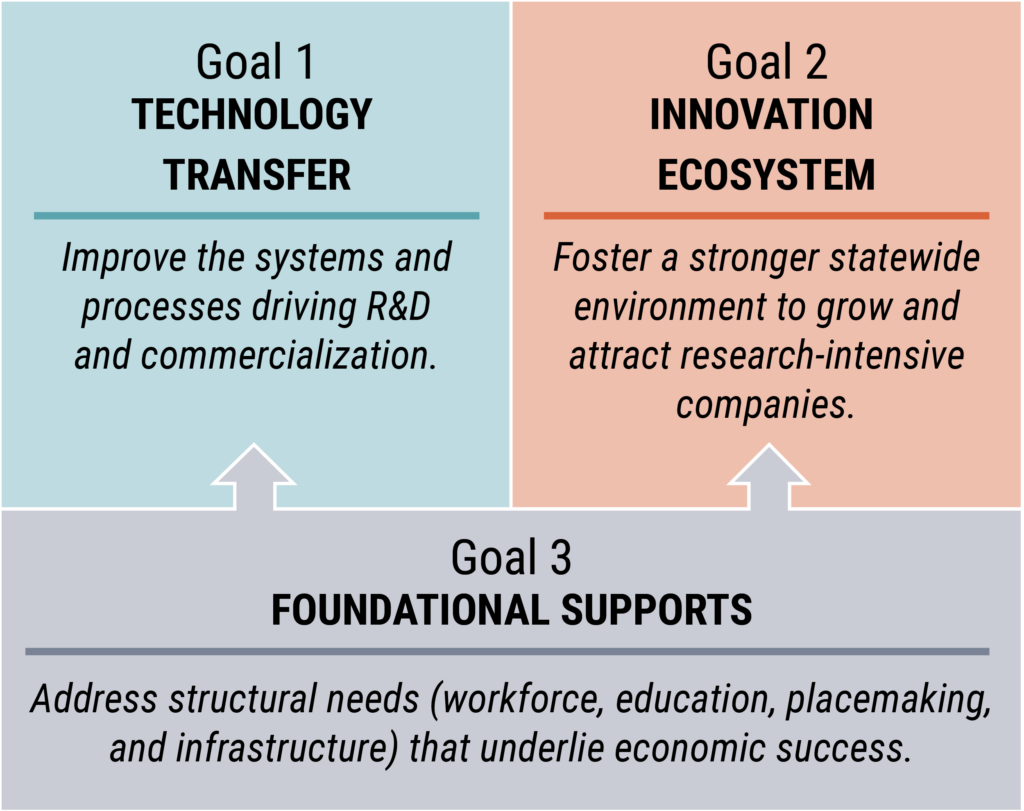Higher education assets are crucial to driving robust innovation economies. TIP’s Talent, Innovation, and Place framework recognizes that universities must be closely integrated with economic development initiatives for communities and regions to flourish. This alignment becomes part of the foundation for lasting success. Two recent TIP-led plans illustrate different models for building an innovation economy through academic and industry partnerships. In Texas, the state’s decentralized approach means coordinating efforts across a vast network of diverse stakeholders, leveraging the state’s expansive geography and industry mix, and working collectively to retain commercialized innovations. In Mississippi, success comes from leveraging the many assets of this small but asset-rich state.
Although the specific assets, strategies, and implementation partners were vastly different, the plans used a common strategic framework to examine how to best support and leverage research universities for economic development in each state. This flexible, three-tiered framework provides a conceptual starting point for linking university R&D to regional and state-level economies. The primary focus is academic R&D and technology commercialization. Extending one level outward is the innovation and entrepreneurship ecosystem—investors, founders, business and industry, community organizations, and local governments. And extending beyond that is the foundational support—including talent, infrastructure, and other supports—for success in the innovation economy.

The Texas Model
Texas is famous among economic developers for prioritizing local action over a statewide approach. This decentralized model is equally visible in higher education. While public universities in states like California and North Carolina fall under only one or two systems, Texas has seven separate university systems and numerous individual institutions. The state’s vast geography, the diffuse nature of its institutions, and the inherent lack of density present challenges and opportunities for building an innovation economy. This is where a robust strategic planning effort led by a statewide organization like the Texas Higher Education Coordinating Board (THECB) plays a pivotal role. Strengthening Texas’s innovation and commercialization efforts through creative collaborations and increased investments in foundational assets was the focus of THECB’s state-level strategy, From Insights to Impact: Fostering Innovation Through Texas Higher Education.
Texas’s large and varied stakeholder network and its widely dispersed institutions create challenges to effective coordination and to achieving the density of assets required for success. Well-established ecosystems like Silicon Valley and Boston are magnets for innovation largely because of their dense networks of research universities, capital sources, and STEM talent. Yet, Texas’s geographic scale and distinct regions also offer the state a significant opportunity. An important observation that emerged during the From Insights to Impact planning process was the need to better connect academic research with the major economic drivers of each region. This geographic and sector-based perspective helps ensure the teaching and research functions of universities are better aligned with the specific needs of the state’s major companies and industries.
The opportunity for Texas is exciting. No other state has the same combination of ingredients: the most public research universities, a rapidly growing skilled workforce, engaged local and regional economic development partners, and innovative industry clusters (including finance and corporate services in Dallas-Fort Worth, software and semiconductors in Austin, energy in Houston, military and defense in San Antonio, and multiple emerging life sciences clusters).
Yet despite its many advantages, an in-depth analysis conducted as part of the planning process found that the Lone Star state underperforms its potential relative to peer states on key metrics. Academic R&D at Texas institutions too often does not lead to economic benefits for the state. Innovations born out of Texas universities are frequently commercialized in California and the northeast, drawn by the density of investor and startup talent networks in areas like Silicon Valley, New York City, and Boston’s Route 128 Corridor.
Texas is addressing this gap head-on with major new investments from the legislature. These include a nearly $4 billion endowment to expand research activities at qualifying universities, almost $700 million to invest in university facilities for semiconductor research, and $400 million to increase community college financing with a focus on credentials of value in high-demand fields. With a new strategic tech commercialization and innovation plan by the THECB and a supportive legislative agenda, the state is well positioned to lead the nation in translating academic research into commercialized products and economic development.
The Opportunity for Mississippi
While it lacks Texas’s scale, Mississippi’s innovation opportunities are equally exciting. Leveraging the state’s many economic assets through the implementation of the Mississippi Innovation Plan could cement it as one of the nation’s most forward-looking states.
Chief among those assets is the strong history of collaboration among the state’s four research universities—Jackson State University (JSU), Mississippi State University (MSU), the University of Mississippi (UM), and the University of Southern Mississippi (USM)—via the Mississippi Research Consortium (MRC). Formed in 1986, the MRC aims to develop and sustain nationally competitive research programs in the state. MRC’s success as a driver of innovation and funding is illustrated by the recent National Science Foundation Regional Innovation Engines awards granted to three MRC universities: $1 million to MSU for capitalizing on autonomous technologies in advanced manufacturing and $1 million to a joint initiative by JSU and USM for advancing food security and climate resilience. TIP is supporting the latter by providing the strategic planning and advisory services needed to prepare a successful Engines application for up to $160 million. Mississippi has also had successes with startups and large companies in innovative target sectors like advanced materials, blue economy, aerospace and defense, IT, and agriculture.
University innovation is similarly benefiting Mississippi’s communities. Opportunities have emerged to create innovation districts and technology hubs in cities such as Vicksburg, Gulfport, and Jackson. Communities have invested in placemaking, ensuring they are better positioned to attract talent and companies. Cities like Tupelo, Oxford, Starkville, Ocean Springs, Pascagoula, Biloxi, and Greenwood represent best practices because of their sustained emphasis on main street redevelopment. These local investments are amplified by efforts to rebrand the state, including grassroots initiatives that embrace its rich cultural heritage (evidenced in its food, music, history, and diverse population) and intentional efforts, such as the new “Mighty Mississippi” brand for business development promoted by the Mississippi Development Authority (MDA).
The statewide strategic planning process identified several areas where Mississippi is moving in the right direction; however, barriers to building an innovation economy remain. The loss of talent to other states and regions, particularly in the Millennial and Gen-Z generations, is among Mississippi’s largest challenges. The state has a successful track record of incentivizing and recruiting large industrial relocations but has not paid enough attention to startups and high-growth technology firms. Startup activity, risk capital availability, and professional services providers are all under-represented in Mississippi. Finally, as the state capital and largest urban area, Jackson has a vital role in Mississippi’s overall economic health and must be an integral part of efforts to grow and attract research- and technology-intensive companies.
Implementation of the Mississippi Innovation Plan rests largely on the MRC and the MDA, with support and funding from the governor and legislature. Success will also depend on support from a range of other innovation-oriented organizations across the state, such as Innovate MS and Accelerate MS, and engagement from local economic development organizations.
Takeaways
- Extend the impact of research universities. Research universities will not live up to their full economic potential unless they extend beyond their flagship campuses and the college towns they are based in. USM’s facilities in Coastal Mississippi focused on blue economy innovation and Texas A&M’s new downtown Fort Worth campus are two examples. The same lesson is true for other higher education partners—even those that are not major research universities—including liberal arts universities and community colleges. Degree and certificate programs that build a pipeline of future talent for innovative industries and capstone programs and internships linking students with employers are two of the most important ways higher education supports economic development.
- Pay attention to nonacademic research facilities. While higher education is a cornerstone of America’s innovation economy, other institutions ranging from military and defense agencies to federal research facilities and nonprofit research institutions are also important players in research and technology development. In Vicksburg, Mississippi, the US Army Engineer Research and Development Center (ERDC) accounts for $1.2 billion of annual R&D investments, roughly twice as much as the state’s research universities combined. In San Antonio, military and defense agencies, including Joint Base San Antonio and the NSA, along with nonprofit research institutes (Southwest Research Institute and Texas Biomedical Research Institute) advance science and technology across the Texas and national economy.
- Encourage partnerships across state lines. University research is commonly conducted through consortiums of academic researchers partnering across numerous institutions spanning multiple states and even countries. In Mississippi’s case, the long-term transformation into a more tech-driven economy will involve partnerships with surrounding metropolitan areas including Memphis (medical and logistics) and New Orleans (energy and blue economy industries). In Texas, collaboration with surrounding US states and northern Mexico—around the automotive supply chain, in particular—will fuel innovation and economic growth.
- Seek out public and philanthropic funding. The desired outcome of innovation-focused economic development strategies is private sector investment and industry growth, but public investments—especially state and federal funding—are often a prerequisite. Public and philanthropic funding has played an essential role in driving innovations. Examples include Pegasus Park in Dallas, MCity in Vicksburg, and numerous organizations in other states like NCInnovation in North Carolina and Lilly Endowment in Indiana. Major corporations are also innovation drivers through their philanthropic efforts, such as Microsoft’s TechSpark initiative. Microsoft is active in Mississippi through its STEM education efforts and has been a lynchpin (in partnership with the Green Bay Packers) in building up the innovation and entrepreneurship ecosystem in greater Green Bay and across Wisconsin.
With these takeaways in mind and a strong strategic framework on which to build, economic developers can leverage higher education as drivers of innovation. Intentional planning and strong partnerships are critical to R&D that simultaneously spurs economic growth at the community-level and ensures competitiveness in the global innovation economy.



